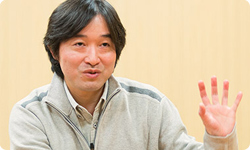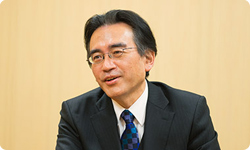At the start of our chat, you mentioned you wanted to make a JRPG masterpiece. What were your ideas for making that happen?
To give a brief outline of the structure of JRPG, first you have the story as the y-axis, and the game system and game play as the x-axis, and it’s really important to keep those two things balanced.
It can’t lean too much to the story side or the game system side.
That’s true. Now, before we built Monolith Soft, we were working at Square20…20. Square: Currently Square Enix Holdings Co., Ltd. Square, founded in 1986, merged with Enix in 2003.
So this was Square, before it became Square Enix.
Right. I joined right after the development of Final Fantasy III21 had ended, and I was involved in IV, V and VI22. Final Fantasy was always one of those titles that had the x-axis of gameplay, but where a lot of care went into the y-axis of the story. It was a lot of fun to debug. Someone was always playing through the whole game on the development deadline day!21. Final Fantasy III: The third game in the series, released for NES in Japan only during 1990.22. IV, V and VI: Final Fantasy IV (released for Super NES in Japan and America during 1991, available for Wii Virtual Console in Europe); Final Fantasy V (released for Super NES in Japan only during 1992); and Final Fantasy VI (released for Super NES in Japan and America during 1994, available for Wii Virtual Console in Europe).
That was a tradition for the Final Fantasy team.
That’s right. (Hironobu) Sakaguchi-san23 and the rest of us would watch the play through, and when it finally finished successfully, we would all cheer. It was a lot of fun.23. Hironobu Sakaguchi: The creator of the Final Fantasy series. In 2001, he formed his own game development company, Mistwalker Corporation.
Right.
But after that – and this is my own failing, as well – I felt like, more and more, the y-axis of the story started to overtake the x-axis of the gameplay.
Ah, you felt that, as a JRPG, the balance was off.
Right. So the first thing I did when I was making Xenoblade Chronicles was to use my experiences to decide what a good balance was for the x-axis and y-axis, and structure it that way.

It must be the fact that you made sure that the x-axis of the gameplay was just as rich as the story of the y-axis, that gave the game such depth.
I think so.
You must have had a lot of trials, even after you figured out your direction.
It was less about trials, and closer to burning bridges.
Burning bridges? What do you mean?
We began Monolith Soft in 1999, with funding from Namco24 before it became Bandai Namco. The first game we made was Xenosaga25, but because we were developing it while we were building the organisation, we didn’t have enough people. The programmers and the planners were all rookies. At the time, the director of Xenoblade Chronicles and Xenoblade Chronicles X26, (Koh) Kojima27, had just joined the company, right after graduating from college. 24. Namco: BANDAI NAMCO Games Inc. Namco, which opened in 1955, merged its game department with Bandai in 2006.25. Xenosaga: Xenosaga Episode I: Der Wille zur Macht, an RPG published by Namco in 2002.26. Xenoblade Chronicles X: Tetsuya Takahashi’s latest RPG for Wii U. A European release is planned for 2015.27. Koh Kojima: A member of the Development Department at Monolith Soft, also director on Xenoblade Chronicles. Appears in Iwata Asks: Xenoblade Chronicles, Vol. 3: The Development Process.
So even Kojima-san was a rookie.
That’s right. And it’s a bit embarrassing to admit, but the graphics engine was only completed six months before the development deadline. That’s the schedule we were on.
Now that sounds like a fierce schedule.
So – and this is a bit of an excuse – but at the time, I felt that because no-one on the team making Xenosaga had any experience, it might be a little too difficult for us to make our ideal game yet.
Right.
But even on that team, we had a few extremely-talented graphic designers. The game design came out of the idea that “the only thing we can do is make the main component some sort of event.”
So you designed a game that played to the strengths and weaknesses of your team.
That’s right. We released three games in the Xenosaga series28, but they weren’t very well received. It was really mortifying. All of the young team members felt that way, not just the leaders. So we all decided, “Next time we need to make a game that players will enjoy.” So that made the atmosphere during the Xenoblade Chronicles development very different compared to other games.28. Three games in the Xenosaga series: An RPG series running from 2002 to 2006.
You couldn’t make excuses any more.

That’s right. We couldn’t run any more. And that’s why I say we burned our bridges for the Xenoblade Chronicles development.
Sometimes, experiencing adversity like that can turn into a step up to success. The game is a completely different genre, but a similar thing happened with Animal Crossing29.29. Animal Crossing: A series of communication games. The first game in the series was released in September 2004 in Europe for Nintendo GameCube, with successive titles for Nintendo DS, Wii and Nintendo 3DS.
With Animal Crossing?
Yes. Animal Crossing for Nintendo DS30 received rave reviews, but the Wii version31, which was released shortly after, couldn’t entirely live up to user expectations. The people who were involved in the Wii version were really worried about that, and they used it to propel themselves to create the Nintendo 3DS version of Animal Crossing32. One of the people who had been at the heart of that project produced Splatoon33, which is planned for release in May 2015.30. Animal Crossing for Nintendo DS: Animal Crossing: Wild World, released in Europe in March 2006.31. The Wii version: Animal Crossing: Let’s Go to the City, released in Europe in December 2008.32. The Nintendo 3DS version of Animal Crossing: Animal Crossing: New Leaf, released in Europe in June 2012.33. Splatoon: A game for Wii U, releasing in May 2015. It is produced by Hisashi Nogami, who was Series Director on Animal Crossing through Animal Crossing: Let’s Go to the City. For more on Animal Crossing, see: Iwata Asks: Animal Crossing: Let’s Go to the City. For more information on Splatoon, see the official Splatoon website.
Oh, is that so?
So, I don’t feel like we make a game and then it’s finished. I feel like they are all connected. That is to say, if the Wii version of Animal Crossing had garnered a positive response, maybe Splatoon wouldn’t have been created, or the Nintendo 3DS version of Animal Crossing might not have been the breakthrough it was. They probably would have been quite different.
That’s quite true.
But when we make a game, we want to fulfil user expectations 100% – even 120%. We’re very serious about that – we’ve never wavered in our commitment to that philosophy. But sometimes, even when we have a product that we’re very confident about, users tell us, “This isn’t what we wanted.”
That’s true.
When that happens, we often have the users tell us what didn’t work for them, or what part of the build-up wasn’t right. So in a way, when it came to making Xenoblade Chronicles, it actually turned out to be a great source of strength that the development team had faced problems with the previous three Xenosaga games.
Exactly. But when we made Xenoblade Chronicles, 10 years had passed since Monolith Soft was built, and the team members had all gained experience.
And Kojima-san, who was a rookie when the company started, has become a director.
Yes. It really confirmed the fact that, with these team members, we could make something with a balanced x-axis and y-axis.
You made Xenoblade Chronicles when you’d all really come into your own as a group.
Yes.
© 2024 Nintendo.